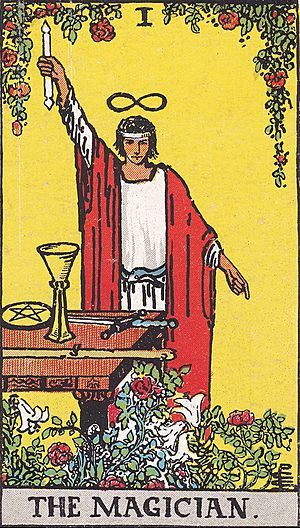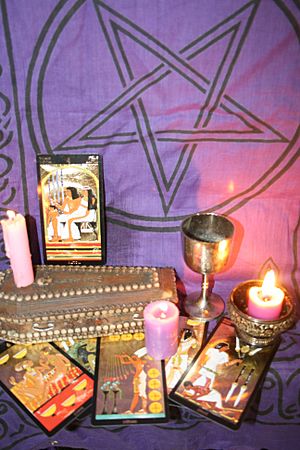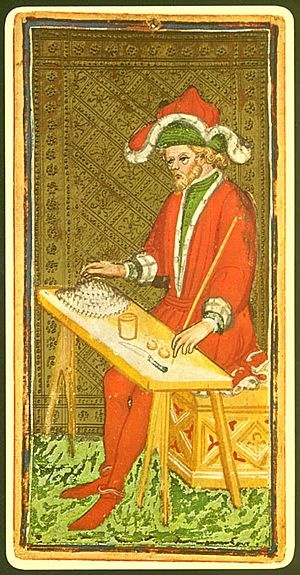Magic (supernatural) facts for kids
Magic (also called magick to distinguish it from stage magic) can mean a way of influencing the world through supernatural, mystical or paranormal means.
This article attempts to provide a general overview of the field of supernatural magic other than stage magic, to provide a rough guide to specific magical traditions and practises. It also discusses the use of magic as a plot device in various kinds of fiction.
However, the term magic is used in many other contexts in other articles, some of which may be very similar to the one discussed in this article and some of which may be different and distinct.
Contents
History of magical beliefs
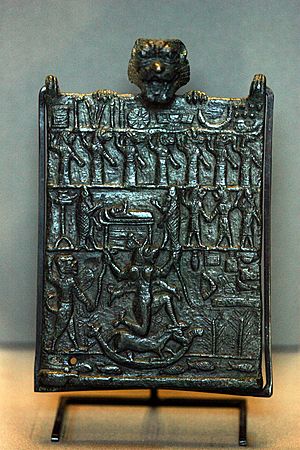
Magical beliefs and practices are common in many cultures and religions.
Officially, Judaism, Christianity and Islam characterize magic as witchcraft, but magical thinking has existed within these religions throughout most of their history. When these religions' views of magic were later applied to the beliefs of other religions, this had the effect of vilifying tribal shamans and other practitioners of magic.
Shamanic and polytheistic traditions have typically been indifferent to monotheistic religion, since there is no inherent conflict between these religions and the existence of other supernatural belief systems.
Examples of the suppression of magical belief and practice range from the eradication of neighboring polytheistic tribes by the early Hebrews, to the attempted suppression and eventual appropriation of pagan holidays by the Catholic Church, to the mingled motives of the Conquistadors, to the Salem witch trials of the Puritans. During such periods, the tendency of magic is to become more obscure and esoteric, with a certain element in society always managing to preserve lore and tradition, often in disguised or metaphorical terms. This pattern gave rise to the term occult.
Varieties of magical practice
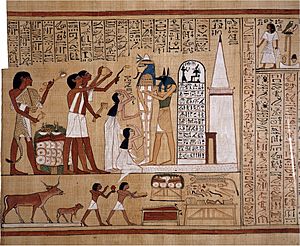
There are several historical varieties of magical practice. Generally, magical intentions can be divided into two general areas. The first is divination, which seeks to reveal information. Varieties of divination include:
Necromancy involves the summoning and conversation with spirits. This can be done either to gain information from the spirits; or it can be done with the intention of commanding those spirits, in which it falls under the second general area of magic; that of casting spells. Included in this broad category are a number of specific magical intentions, such as the weather magic of the rain dance, the physical magic of alchemy, or the making of potions and philtres.
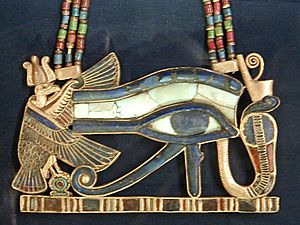
Another method of classifying magic is by "traditions," which in this context typically refer to complexes of magical belief and practice associated with various cultural groups and lineages of transmission. These traditions can compass both divination and spells. Examples of these traditions include:
- hermeticism
- hoodoo
- New Age
- pow-wow
- ritual magick
- Santeria
- Vodun
- Wicca
Some of these traditions are highly specific and culturally circumscribed. Others are more eclectic and syncretistic. When dealing with magic as a tradition, the line often becomes blurry between magic and folk religion.
Magic in fiction
In considering magic as tradition, a related category concerns magic in fiction, where it serves as a plot device, the source of magical artifacts and their quests. Magic has long been a subject of fictional tales, especially in fantasy fiction, where it has been a mainstay from the days of Homer and Apuleius, down through the tales of the Holy Grail, Edmund Spenser's The Faerie Queene, and to contemporary authors from J. R. R. Tolkien to Mercedes Lackey and J. K. Rowling. There may be a well-developed system in fictional magic, or not. It is by no means impossible, moreover, for fictional magic to leap from the pages of fantasy to actual magical practice; such was the fate of the Necronomicon, invented as fiction by H. P. Lovecraft, who sold it so well that there have been several attempts to produce this fabled and dangerous tome of magic.
Modern believers in magic
Many people in the West claim to believe in or practise various forms of magic. The forms of magic they adhere to have been reconstructed from secondary or tertiary sources. The Hermetic Order of the Golden Dawn, Aleister Crowley, and their followers are most often credited with the resurgence of magical tradition in the English speaking world of the 20th century, but in their eagerness to reconstruct the lost traditions of the past, they often included elements of questionable authenticity, or manufactured them from whole cloth. Other, similar movements took place at roughly the same time, centred in France and Germany. Thus, any current tradition which acknowledges the natural elements, the seasons, and the practitioner's relationship with the Earth, Gaia or the Goddess may be correctly regarded as Neopagan, and few such traditions can be sensibly labelled more authentic than any others.
Aleister Crowley preferred the spelling magick, defining it as "the science and art of causing change to occur in conformity with the will." By this, he included "mundane" acts of will as well as ritual magick. In Magick in Theory and Practice, Chapter XIV, Crowley says:
- What is a Magical Operation? It may be defined as any event in nature which is brought to pass by Will. We must not exclude potato-growing or banking from our definition. Let us take a very simple example of a Magical Act: that of a man blowing his nose.
Although some current practitioners of magic prefer the term pagan, Neopaganism is more correct for scholarly reference to current rituals and traditions. Wicca is a more codified form of modern magic than Neopaganism, again owing much to Crowley and his ilk. Wicca and Neopaganism are very different things from Satanism, which owes its structure and memes primarily to inversions of monotheistic texts.
How does magic "work"?
A survey of writings by believers in magic shows that adherents believe that it may work by one or more of these basic principles:
- Natural forces that cannot be detected by science at present, and in fact may not be detectable at all. These magical forces are said to exist in addition to and alongside the four known forces of nature: gravity, electromagnetism, the strong nuclear force and the weak nuclear force.
- A mystical power, such as mana, that exists in all things. This power is often said to be dangerous to people.
- A mysterious interconnection in the cosmos that connects and binds all things, above and beyond the natural forces.
- Manipulation of symbols. Adherents of magical thinking believe that symbols can be used for more than representation: they can magically take on a physical quality of the phenomenon or object that they represent. By manipulating symbols, one is said to be able to manipulate the reality that this symbol represents.
- The principles of Sir James George Frazer, explicated in his The Golden Bough (third edition, 1911-1915). These principles include the "law of similarity" and the "law of contact" or "contagion." These are systematized versions of the manipulation of symbols.
- Concentration or meditation. A certain amount of restricting the mind to some imagined object (or will), according to Aleister Crowley, produces mystical attainment or "an occurrence in the brain characterized essentially by the uniting of subject and object." (Book Four, Part 1: Mysticism) Magick, as defined previously, seeks to aid concentration by constantly recalling the attention to the chosen object (or Will), thereby producing said attainment. For example, if one wishes to concentrate on a God, one might memorize a system of correspondances (perhaps chosen arbitrarily, as this would not affect its usefulness for mystical purposes) and then make every object that one sees "correspond" to said God.
Magical practices
The basic mechanism of magical practices is the spell, a spoken or written formula which is used in conjunction with a particular set of ingredients. If a spell is properly executed and fails to work, then the spell is a fraud. However, in most instances, the failure of a spell to bring about the desired effect can be attributed to the failure of the person executing the spell to follow the magic formula to the letter.
Generally speaking, there are two types of magic: contagious magic and sympathetic magic. Contagious magic involves the use of physical ingredients which were once in contact with the object or objects one hopes to influence with a spell, and sympathetic magic involves the use of physical objects which resemble the object or objects one hopes to influence.
Religious ritual and magical thinking
Viewed from a non-theistic perspective, many religious rituals and beliefs seem similar to, or identical to, magical thinking.
Related to both magic and prayer is religious supplication. This involves a prayer, of even a sacrifice to a supernatural being or god. This god or being is then asked to intervene on behalf of the person offering the prayer.
The difference, in theory, is that prayer requires the assent of a deity with an independent will, who can deny the request. Magic, by contrast is thought to be effective:
- by virtue of the operation itself;
- or by the strength of the magician's will;
- or because the magician believes he can command the spiritual beings addressed by his spells.
In practice, when prayer doesn't work, it means that the god has chosen not to hear nor grant it; when magic fails, it is because of some defect in the casting of the spell itself. It is no wonder that magic tends to be more formulaic and less extempore than prayer. Ritual is the magician's failsafe, the key to any hope for success, and the explanation for failure.
Magic in the archaeological and historical record
Appearing from aboriginal tribes in Australia and New Zealand to rainforest tribes in South America, bush tribes in Africa and pagan tribal groups in Western Europe and Britain, some form of shamanic contact with the spirit world seems to be nearly universal in the early development of human communities. The ancient cave paintings in France are widely speculated to be early magical formulations, intended to produce successful hunts. Much of the Babylonian and Egyptian pictorial writing characters appear derived from the same sources.
Although indigenous magical traditions persist to this day, very early on some communities transitioned from nomadic to agricultural civilizations, and with this shift, the development of spiritual life mirrored that of civic life. Just as tribal elders were consolidated and transformed into kings and bureaucrats, so too were shamans and adepts devolved into priests and a priestly caste.
This shift is by no means in nomenclature alone. While the shaman's task was to negotiate between the tribe and the spirit world, on behalf of the tribe, as directed by the collective will of the tribe, the priest's role was to transfer instructions from the deities to the city-state, on behalf of the deities, as directed by the will of those deities. This shift represents the first major usurpation of power by distancing magic from those participating in that magic. It is at this stage of development that highly codified and elaborate rituals, setting the stage for formal religions, began to emerge, such as the funeral rites of the Egyptians and the sacrifice rituals of the Babylonians, Persians, Aztecs and Mayans.
-
One of the earliest surviving accounts of the Persian mágoi was provided by the Greek historian Herodotus.
-
Hecate, the ancient Greek goddess of magic
-
Many concepts of modern ceremonial magic are heavily influenced by the ideas of Aleister Crowley.
See also
 In Spanish: Magia para niños
In Spanish: Magia para niños


